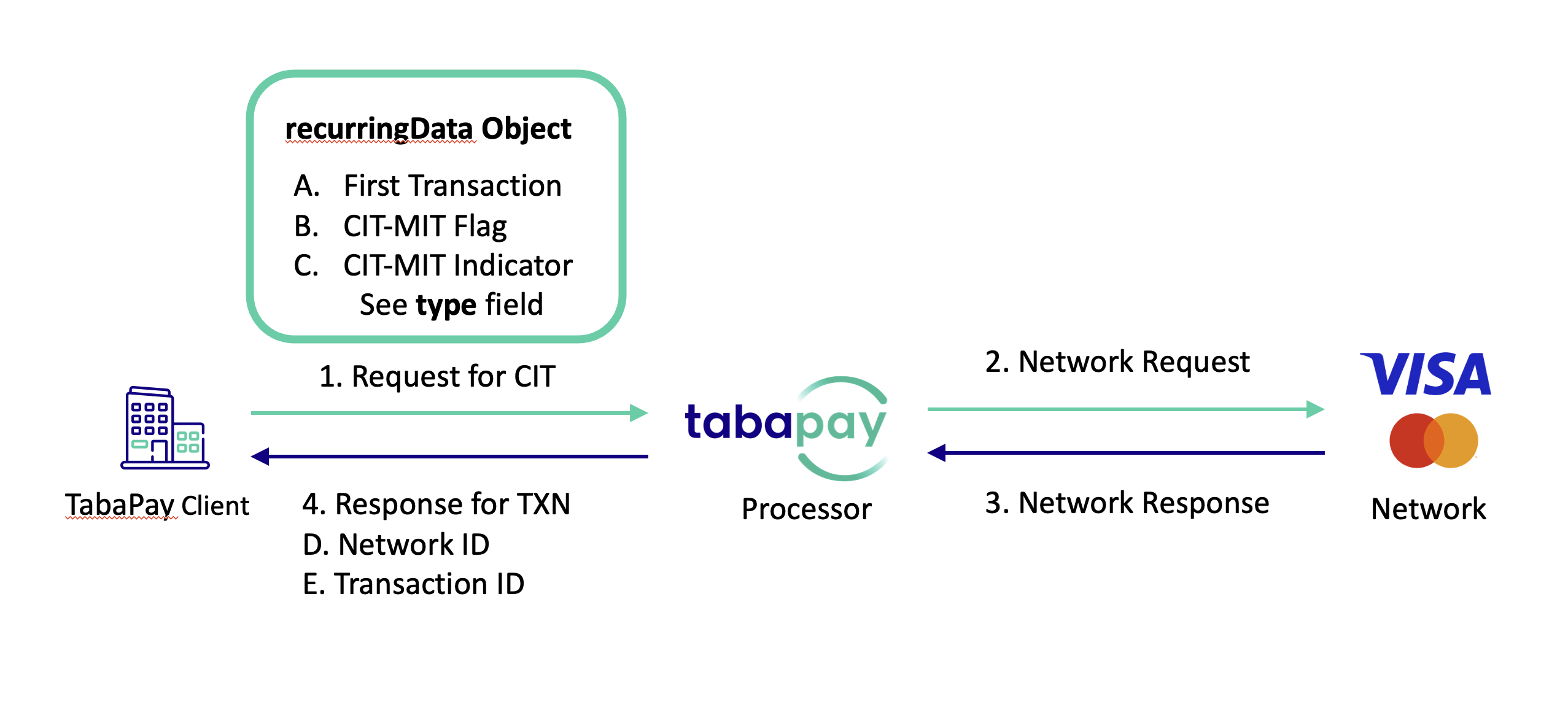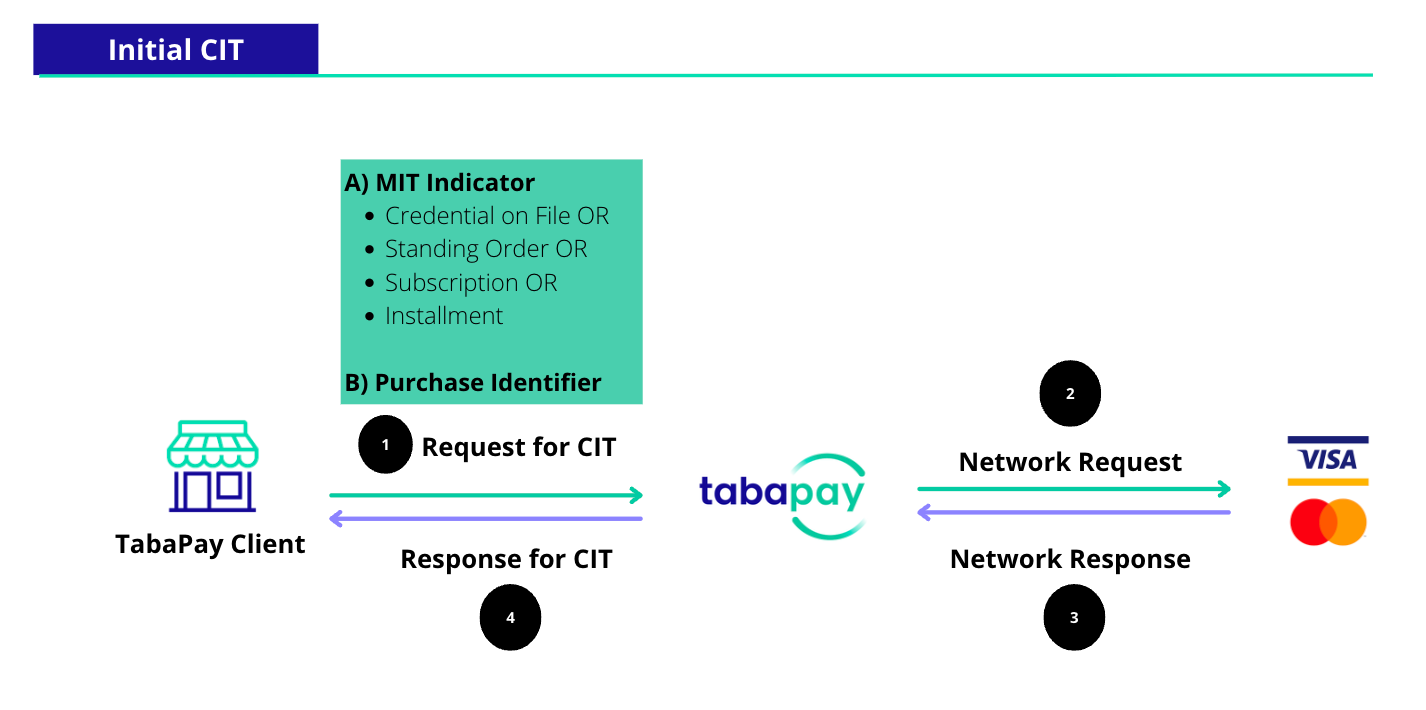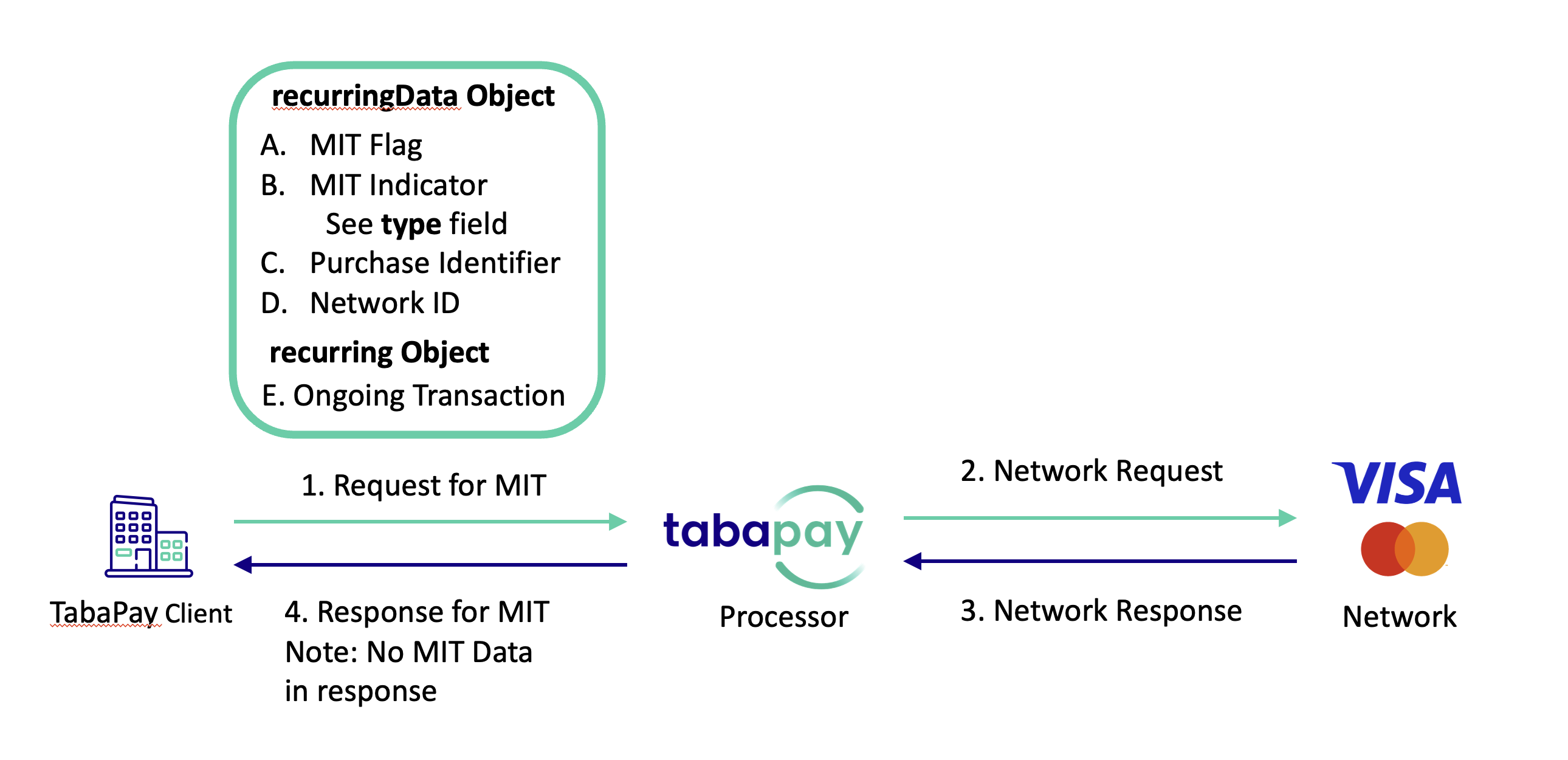Merchant Initiated Transactions (MIT)
Approval to charge customers' cards for ongoing payments without their active participation.
Merchant Initiated Transactions (MIT) is a service for you to charge your customer’s card without their activate participation. A transaction is first made with the cardholder actively present, or a cardholder payment agreement is made for future payments. MIT allows you to store a payment credential-on-file and use it for subscriptions, or on-going payments.
Use Cases
Stored credentials can help provide a seamless way for cardholders to transact online, in-app, or in-person with their favorite merchants. A stored credential-on-file can be used in either a cardholder-initiated or merchant-initiated transaction.
- Subscriptions payments: a subsequent ongoing payment for an e-course or service.
- Hotel additional charges or fees: A hotel charge for mini-bar expenses tallied after the guest has checked-out.
- Billing - Subsequent recurring payment that can vary in amount.
Note: The payment credentials temporarily retained to complete a single purchase are not considered as a stored credential-on-file. For one-time order fulfillment, or purchases made at a customers request refer to our Instant Pull Payments.
Why Use MIT?
- Opportunity for possible improved MIT authorization approval rates
- Higher chance to avoid System Integrity Fees.
- Make better informed authorization decisions, and mitigate risk by increasing the transparency of payments with info used to monitor the proper use of payment credentials.
MIT Payment Flow
The first transaction in most payment workflows begin as a cardholder-initiated transaction (CIT).
A cardholder-initiated transaction is any transaction where the cardholder actively participates in the transaction. This can be either at a terminal in-store or through a checkout experience online, or with a stored payment credential that the cardholder has previously consented to store with the merchant. This is also referred to as a Consumer or Customer Initiated Transaction.
Note: Purchases of services made at a consumer’s request, such as ordering a ride are considered CITs because the cardholder is actively participating in the transaction.
Initial CIT


Subsequent MIT

Default Behavior for TabaPay Tokens
If you store TabaPay Tokens, the transactions that are performed using a TabaPay Account ID, will be by default considered as:
- Card on File for all Visa transactions
- Cardholder Initiated (CIT) Credential on File for all MasterCard transactions
You can test and develop your customized default behavior, email [email protected] to get started.
How MIT works
Prerequisites
Clients need to register for a VMID (Visa Merchant ID) that corresponds with each Client ID. To get started and enable MIT email [email protected].
Note: Mastercard does not require registration.
General API Prerequisites
If you are using TabaPay Tokens for Source Account information, be sure to grab the accountID originally generated from Create Account.
Clients handling sensitive card data must comply with Payment Card Industry Data Security Standards (PCI-DSS).
Note: All requests should be in a compressed format.
1. Create Transaction
The Create Transaction API request body parameters for MIT includes the following:
initiator: CIT-MIT Flagtype: MIT indicatorid: Purchase IdentifiernetworkID: Original Network ID when CIT-MIT flag is MIT
CIT-MIT Flag:
Indicates to TabaPay whether the TabaPay Client is performing a cardholder-initiated or a merchant-initiated transaction.
- Use
Cwhen consumer initiates the transaction - Use
Mwhen the consumer is not present
MIT Indicator
This field contains an indicator for different use cases of recurring payments, utility bills, installments credential on file or standing orders all when the cardholder and merchant have agreed to the cardholders account being charged without their active participation.
For more values for the MIT type or indicator, refer to CIT-MIT Indicators, or the Create Transaction API fields under recurringData.
Purchase Identifier
A client generated unique identifier can remain the same for both the initial CIT and subsequent MITs. This helps issuers link transactions and can improve approval rates.
Note: Use the same id from the CIT in all related MITs.
Original Network ID when CIT-MIT flag is MIT
For subsequent MITs, TabaPay Clients must pass the networkID in the Create Transaction API request body taken from the response of the original first CIT.
2. Original First CIT Response
See the "networkID": "407903181027", in the response. For full response field descriptions, refer to Create Transaction API response.
{
"SC": 200,
"EC": "0",
"transactionID": "k5KnKwhgeita2lMToD9BQQ",
"network": "Visa",
"networkRC": "00",
"networkID": "407903181027", //<-------networkID here
"status": "COMPLETED",
"approvalCode": "210558",
"AVS": {
"codeSecurityCode": "M"
},
"card": {
"last4": "1111",
"expirationDate": "202708",
"nameFI": "Whoop I.E. Institution"
}
}3. Subsequent MIT Request
The same networkID is included in the subsequent MIT request, "networkID": "407903181027",
...
"pullOptions": {
"recurringData": {
"initiator": "M",
"type": "S",
"id": "hqMZ-UEE2YEiYOj6HPxEXQ", //<----- networkID included here
"networkID": "407903181027
},
"rec
...Note: For the full request for Visa or Mastercard MITs, refer to the Recipes section.
MIT Compliance
- CIT and MIT help meet network mandates and avoid System Integrity Fees.
- Visa Configurations: Visa Account Funding Transactions (AFTs) are permitted for use as Merchant-initiated transactions/Recurring transactions.
- Mastercard Configurations: MoneySend payment or funding transactions, gaming payment transactions do not require CIT or MIT indicators.
- Authenticating and Validating Cards: Card validation, or authentication (e.g. CVV2, 3DS) are performed for CITs.
MIT Recipes (Code Samples)
MIT FAQs
1. How do I participate in TabaPay’s MIT service?
Contact [email protected] or reach out to your TabaPay Representative to register for TabaPay MIT. Each network requires registration and we want to make sure you are suitably enabled.
2. What issuer decline reason codes will prevent the Original record from being stored?
| Value | Response Code | Description |
|---|---|---|
| 04 | Pickup Card (no fraud) | A card has been canceled |
| 07 | Pickup card, special condition (fraud account) | Fraud-compromised account |
| 14 | Invalid account number (no such number) | Account number is not valid |
| 41 | Lost card - pickup | Cardholder has reported the card lost |
| 43 | Stolen card - pickup | Cardholder has reported card stolen |
| 46 | Closed Account | Account is closed |
3. How does this process work with TabaPay Account Updater?
TabaPay Account Updater works independently of TabaPay MIT Service and if a credential is updated, it will be used in the MIT transaction.
4. How do I use MIT in combination with Apple Pay Merchant tokens?
Apple Pay Merchant tokens MUST provide the MIT-CIT flag as well as the MIT indicator.
When using [Apple Pay Merchant tokens, depending on the value of the CIT-MIT flag, cryptogram may or may not be required:
- If flag is CIT, mobile pay object requires cryptogram
- If flag is MIT, mobile pay object does not require cryptogram. Along with this MIT flag, merchant must include original transaction ID.
5. In what situations will MIT not be allowed for an initial CIT?
When the network response code is any of these for the initial CIT:
- 04 - Pickup Card (No fraud)
- 07 - Pickup Card, Special Condition (fraud account)
- 14 - Invalid Account Number
- 41 - Lost Card - Pick up
- 43 - Stolen Card - Pick up
- 46 - Closed Account
More Recipes
Updated 29 days ago
